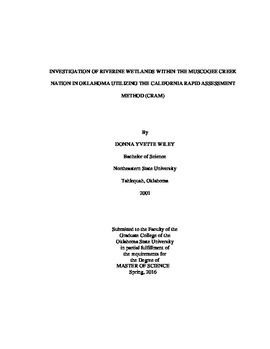| dc.description.abstract | Wetlands are an important part of our natural landscape. Wetland rapid assessments are useful tools for natural resource managers to evaluate existing wetlands. Oklahoma has not completed the development of a custom rapid assessment method (RAM), which hinders other entities interested in pursuing assessments and protection of wetlands, such as Native American Tribes. Recently the Muscogee Creek Nation (MCN), an Oklahoma tribe, has begun to develop a wetland program. This thesis further discusses the justification for all tribes to develop a wetland program, using the MCN as a case study. To further develop their wetland program, the MCN needed a RAM to assess riverine wetlands. The California Rapid Assessment Method (CRAM) was applied and tested on riverine wetlands in East-Central Oklahoma. The CRAM was conducted on 21 wetlands located within the tribal boundaries. An additional, broader assessment using a geographical information system (GIS) for buffers at three different scales was also completed to document land-use type at three buffer scales. The percentage of land-use type at each scale was compared to the CRAM metric scores to determine if a correlation exists. Previous research has shown that land-use impacts the condition of streams and wetlands. This study confirmed the CRAM scored riverine wetlands correlated to degree of disturbance; the correlation was positive with little human impact, and negative with a higher degree of disturbance. Next, three of the 21 wetlands were used in a sensitivity analysis, one each for a low, a moderate, and a high CRAM score. The twelve scenarios where the highest degree of sensitivity on final CRAM results, ranging from 5 � 14.5%, are highlighted. The sensitivity analysis results can be utilized by CRAM practitioners to know which parameters are most sensitive to measurement error. In conclusion, this thesis demonstrates the application of the CRAM on wetlands within the MCN in Oklahoma, and also documents land-use and operational factors that can impact the final CRAM score. | |
